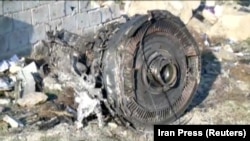Iran has given Ukrainian investigators access to the fragments of an airliner that crashed earlier this week near Tehran and invited Boeing and the U.S. accident-investigation agency to help in the probe of the incident that killed 176 people.
A statement from Ukrainian President Volodymyr Zelenskiy’s office also said that DNA was being collected from relatives of Ukrainians who died in the crash in order to identify the bodies.
However, the statement said, "It is too early on in the investigation to reveal specific details."
The Ukrainian plane was en route to Kyiv when it crashed on January 8 after taking off from the Iranian capital, killing all on board.
The victims were 63 Canadians, 82 Iranians, 10 Swedes, four Afghans, three Germans, and three Britons. There were also 11 Ukrainians on board, including nine crew.
Earlier on January 10, in a reversal from its earlier stance, Iran said it had invited the U.S. National Transportation Safety Board (NTSB) and plane maker Boeing to participate in the crash investigation.
The decision came after U.S., Canadian, and British officials said it was “highly likely” that the Ukraine International Airlines (UIA) flight had been shot down, probably in error, by an Iranian missile.
Iranian officials have vehemently denied their forces shot down the Boeing 737-800 jet and have called on Western nations to share any intelligence suggesting it did so.
Ali Abedzadeh, head of the Iranian aviation authority, said that along with representatives from the U.S. National Transportation Safety Board (NTSB) and plane maker Boeing, Tehran will allow experts from Ukraine, France, and Canada to participate in the crash investigation.
Under rules established by the UN aviation organization, the NTSB is entitled to participate in the investigation because the crash involved a Boeing jet that was designed and built in the United States.
Amid tensions heightened by the killing of top Iranian general Qasem Soleimani in a U.S. air strike in Baghdad last week, Iran earlier had said it would not give the plane’s so-called black boxes, which contain flight data and cockpit voice recorders, to either U.S. authorities, nor to Boeing representatives.
Any involvement by the NTSB could be limited because of restrictions related to financial sanctions placed on Tehran by the American government.
The board, an independent U.S. government agency charged with probing civil aviation accidents, said it was evaluating its “level of participation in the investigation.”
It confirmed it had received notification of the crash from Iran, the formal process that gives the U.S. agency the right to seek participation in the investigation.
The NTSB said it has named an accredited representative to the case, but did not say when or if the person would be allowed to visit the site.
Earlier, Canadian Prime Minister Justin Trudeau said in a news conference in Ottawa that evidence suggested an Iranian missile downed the Ukrainian passenger plane that was flying from Tehran to Kyiv.
"We have intelligence from multiple sources, including our allies and our own intelligence. The evidence indicates that the plane was shot down by an Iranian surface-to-air missile," Trudeau said.
"This may well have been unintentional," he told a press conference, calling for a "complete and credible investigation" into the cause of the crash.
The Ukrainian plane was en route to Kyiv when it crashed after taking off from the Iranian capital, killing all on board.
The victims were 63 Canadians, 82 Iranians, 10 Swedes, four Afghans, three Germans, and three Britons. There were also 11 Ukrainians on board, including nine crew.
The tragedy came hours after Iran fired missiles at bases housing U.S. forces in Iraq, prompting speculation that the plane may have been attacked.
Trudeau's comments came as video, which The New York Times says it has verified, emerged that may show the moment the airliner was hit.
The video shows a fast-moving object heading into the sky before a bright flash is seen. Several seconds later, an explosion is heard.
Echoing Trudeau’s words, British Prime Minister Boris Johnson said: “There is now a body of information that the flight was shot down by an Iranian surface-to-air Missile.”
“This may well have been unintentional," Johnson added.
U.S. President Donald Trump said he had "suspicions" about the crash, saying the plane “was flying in a pretty rough neighborhood and somebody could have made a mistake."
Unidentified U.S. officials said they were confident that Iranian air-defense systems downed the Boeing 737-800, based on satellite, radar, and electronic data.
Ukraine's top security official, Oleksiy Danilov, said the country was examining whether a missile strike brought down the aircraft.
Newsweek magazine quoted a Pentagon and a senior U.S. intelligence official, as well as an Iraqi intelligence official, as saying they believed the Ukrainian plane was hit by a Russian-made Tor missile.
Iran's Transport Ministry said that "this story of a missile striking a plane cannot be correct at all."
"Several internal and international flights were flying at the same time in Iranian airspace at the same altitude of 8,000 feet [2,440 meters]," the ministry said.
"Such rumors make no sense," Iranian aviation chief Abedzadeh said.
Ukrainian President Volodymyr Zelenskiy said he spoke with his Iranian counterpart, who assured him of full cooperation in the investigation and that Tehran would provide experts access to all data.
“The Iranian party assured full cooperation with a view to holding an objective investigation and finding out the causes of the tragedy. Hassan Rohani stressed that Iran would provide the Ukrainian expert group with prompt access to all the necessary data,” a Ukrainian presidential statement said.
Ukrainian Investigators Examine Plane Fragments From Iran Crash, Says Zelenskiy's Office
- By RFE/RL

With reporting by AP, Reuters, Newsweek, CNN, AFP, and CBS, Fars, dpa, IRNA, and RFE/RL’s Radio Farda




